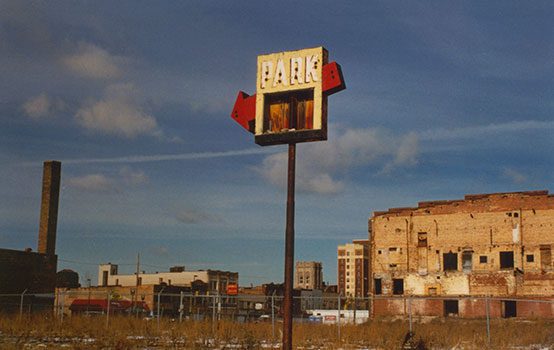What the Rust Belt Can Learn from Rio

The hilariously mordant James Howard Kunstler once wrote a blog post about driving through northwest Indiana, noting the “ghostly remnants of factories” and neighborhoods “foreclosed and shuttered,” “places of such stunning, relentless dreariness that you felt depressed just imagining how depressed the remaining denizens of the endless blocks of run-down shoebox houses must feel…There was a Chernobyl-like grandeur to it, as of the longed-for end of something enormous that hadn’t worked out well.”
My own leafy town of Valparaiso is part of this region of over 700,000 that includes no major urban centers, only small cities and towns, none of them over 80,000. They include such locales as Gary, East Chicago, Hammond, Michigan City, La Porte, Crown Point, Portage and Chesterton. Thinking of the map of Lake Michigan, I sometimes describe our post-industrial landscape as “the bottom of the lake.”
Earlier this month, nearby this gritty spectacle at the University of Notre Dame in South Bend, Front Porch Republic held its annual meeting. (The name of the group sounds like a breakaway comic-opera kingdom, perhaps a cousin of Groucho Marx’s Fredonia. In fact, FPR is a collection of writers, academics and genial cranks who all emphasize the local over the remote.) In comments at Notre Dame, I wondered what exactly is supposed to be our collective fate here in “the region,” as locals like to call it. Is Creative Class guru Richard Florida correct that our lack of information-economy resources means we’re doomed to just fade away? Should we take Harvard economist Ed Glaeser’s advice and work to become more integrated into the neoliberal Chicago megaregion?
Perhaps what places like northern Indiana need is not innovation, but unnovation—to use a term coined by Boston-based journalist Ben Schreckinger. The idea is to resist the magical thinking that our little towns can ensure meteoric growth by trying to launch tech companies with virtually no resident tech talent. Forget Silicon Valley and Route 128 and the endless glorification of knowledge work (you might think of proto-Porcher Wendell Berry here): in the rustbelt, we need a return to economic roots. Schreckinger argues that non-urban Massachusetts—he might have said most of Indiana as well—should return to its traditional industries of farming and manufacturing, both of which have deep cultural roots (outside the big cities) as well as new technological tools.
Also worth considering is Catherine Tumber’s contrarian vision of the resilient post-industrial cities and towns of the future. She argues that pace the wiseguys like Florida or Glaeser, it is we rust-belters who are well-positioned for the future economy. That’s because our places will be “small, gritty and green” (from her book of the same name).
Here’s what she means. First, smaller cities and towns (under a half million in population) are built on a more sustainable scale and can often achieve consensus more easily. Second, their “grittiness” is their cultural memory of manufacturing and heavier industry, one example of which is Muncie, Indiana’s current national prominence in the wind energy sector, drawing on its history with corporations such as GM and Westinghouse. Finally, the greenness advantage derives from the way smaller cities and towns can benefit from and contribute to a clean energy economy based on land, manufacturing skills, waterways, and concentrated urban energy markets of their own.
Just for fun, I asked the audience at Notre Dame to guess the location of a real place which had the characteristics of low-rise, high density development; a pedestrian orientation; mixed use (homes above shops); organic architecture (evolves according to need); use of collective action; intricate solidarity networks; and vibrant cultural production. Sounds like Tolkien’s Shire, I know.
The place I had in mind, one I visited several years ago, was in fact the Rocinha favela in Rio de Janeiro. The economy of a Brazilian favela, in many instances, can be an example of a kind of anarchist, self-organizing system, still somewhat free from much governmental involvement—one among several ways in which it typically differs from, say, Chicago’s West Side. These are exuberant, street-lively places built with much more social than economic capital, leading to neighborhood sayings such as “there are no beggars in the favela.” Importantly, they have managed to develop and even prosper outside the usual financial and civic systems.
Given the presence of Rod Dreher at the conference, it was natural to ask: does the Benedict Option have an economic dimension? I suggested that it necessarily had one, citing the Economy of Communion network as a kind of model. The EoC was born within the Focolare organization—a Catholic “ecclesial movement” founded just after World War II—and now has some 700 member businesses worldwide. In its grounding in personalist Christian witness and Catholic social teachings, the group is no quaint collection of handicraft vendors but a sophisticated coalition of triple-bottom line companies. I think their vision offers an important way forward.
Elias Crim is a civic entrepreneur in Valparaiso, Indiana. He blogs at The Dorothy Option and Solidarity Hall.
This post was supported by the Richard H. Driehaus Foundation. Follow New Urbs on Twitter for a feed dedicated to TAC’s coverage of cities, urbanism, and place.
Comments